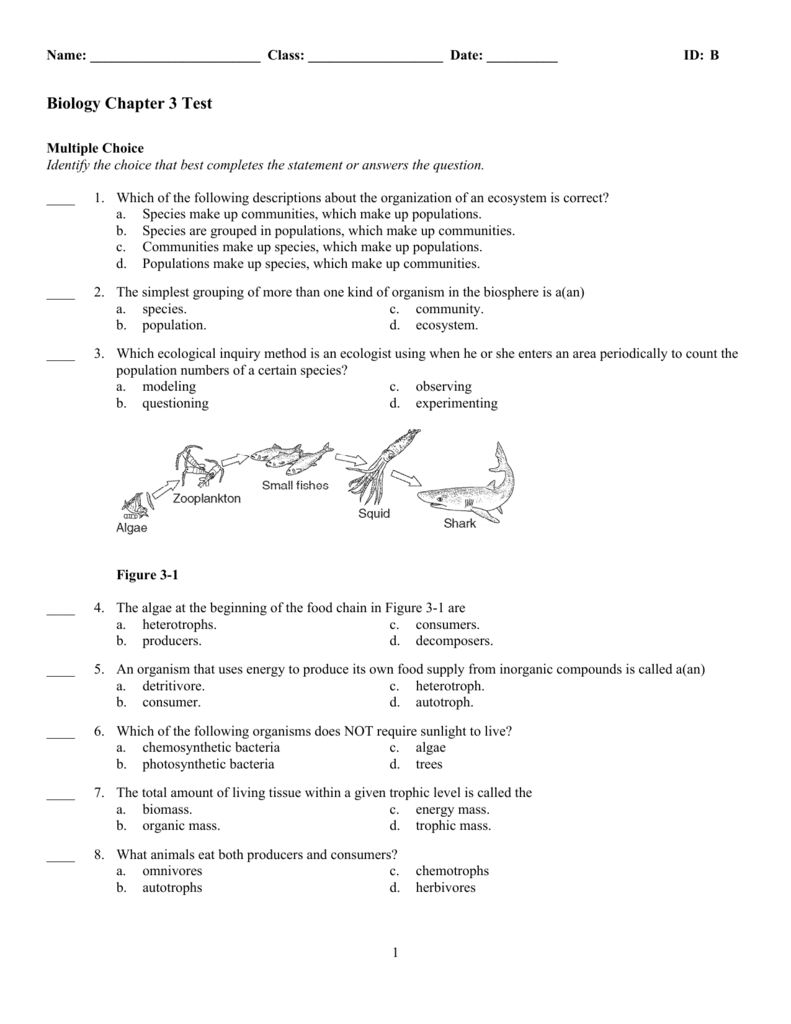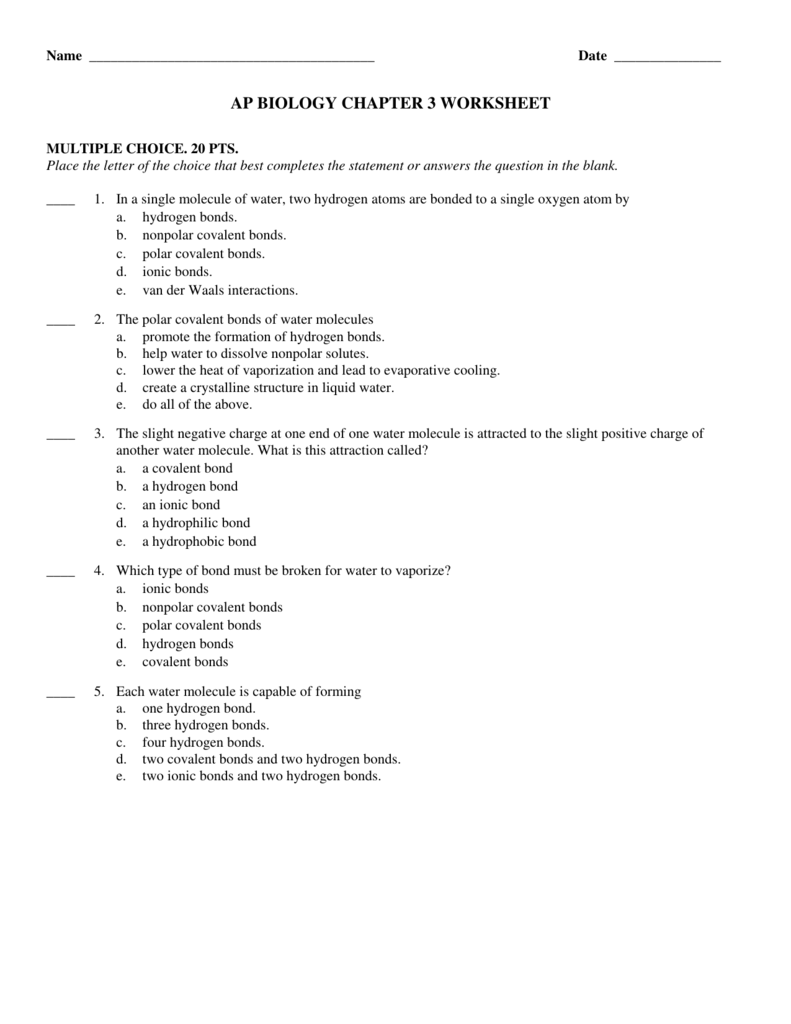Chapter 3 Biology Quizlet
Chapter 3 Biology Quizlet - Macromolecule made of mostly carbon and hydrogen. Name examples of prokaryotic and eukaryotic. Web there are four major classes of biological macromolecules: Also known as simple sugar; Each is an important cell component and performs a wide array of functions. Without this element, the large macromolecules that. Describe the four major types of lipids explain the role of fats in storing energy differentiate between saturated. Web chapter 3 section 3 biology. The chemical basis of life ii: A group of organisms so similar to one another that they can breed and produce fertile offspring.
This element can make stable bonds to itself and to atoms of other elements. Web study with quizlet and memorize flashcards containing terms like function of cell membrane, phospholipids, fluid mosaic model and more. The chemical basis of life ii: Organic molecules introduction certain molecules found in living organisms, such as lipids, contain carbon which are now known as organic molecules. Also known as simple sugar; Web 3.4 proteins highlights learning objectives by the end of this section, you will be able to do the following: Web the large diversity of biological molecules depends on atoms of the element ____. Web there are four major classes of biological macromolecules (carbohydrates, lipids, proteins, and nucleic acids); A group of organisms so similar to one another that they can breed and produce fertile offspring. Macromolecule made of mostly carbon and hydrogen.
A gradient produced by the combined forces of the electrical gradient and the chemical. A carbohydrate polymer consisting of many monosaccharides (sugars). Web there are four major classes of biological macromolecules (carbohydrates, lipids, proteins, and nucleic acids); This element can make stable bonds to itself and to atoms of other elements. Click the card to flip 👆. Web study with quizlet and memorize flashcards containing terms like function of cell membrane, phospholipids, fluid mosaic model and more. The method of transporting material that requires energy. Cram.com makes it easy to get the grade you want! Name examples of prokaryotic and eukaryotic. Quickly memorize the terms, phrases and much more.
, biology chapter 3 YouTube
Web the smallest kind of sugar molecule; Quickly memorize the terms, phrases and much more. Web 1.1 the science of biology; Cram.com makes it easy to get the grade you want! Web there are four major classes of biological macromolecules (carbohydrates, lipids, proteins, and nucleic acids);
Chapter 3 Biological Psychology (Module 1) October 23rd YouTube
Web the large diversity of biological molecules depends on atoms of the element ____. Click the card to flip 👆. Each is an important cell component and performs a wide array of functions. Introduction to cell structure and function 3.2 comparing prokaryotic and eukaryotic cells learning objectives by the end of this section, you will be able to: Web biology.
15+ Chapter 3 Biology LoxaSohail
Web there are four major classes of biological macromolecules (carbohydrates, lipids, proteins, and nucleic acids); Groups of individuals that belong to the same species and live in the same. Made of fatty acid compounds bonded with glycerol molecules. Describe the functions proteins perform in the cell and in tissues discuss the relationship between amino. Web 3.4 proteins highlights learning objectives.
Biology Chapter 3 Worksheet Answers Escolagersonalvesgui
Web chapter 3 section 3 biology. The remaining g3p molecules stay in the cycle to be formed back into rubp, which is ready to react. A group of organisms so similar to one another that they can breed and produce fertile offspring. The theory that states all living things are made up of cells, that cells are the basic units.
Selina Solutions Concise Biology Class 10 Chapter 3 Some
Describe the functions proteins perform in the cell and in tissues discuss the relationship between amino. Macromolecule made of mostly carbon and hydrogen. Introduction to cell structure and function 3.2 comparing prokaryotic and eukaryotic cells learning objectives by the end of this section, you will be able to: Name examples of prokaryotic and eukaryotic. Each is an important cell component.
Biology Quizlet 1 YouTube
Web the smallest kind of sugar molecule; Web biology chapter 3, campbell biology learn with flashcards, games, and more — for free. The remaining g3p molecules stay in the cycle to be formed back into rubp, which is ready to react. This element can make stable bonds to itself and to atoms of other elements. Web 3.4 proteins highlights learning.
Chapter Three The Biological Foundations of Behavior Big Ideas What
Also known as simple sugar; Name examples of prokaryotic and eukaryotic. A gradient produced by the combined forces of the electrical gradient and the chemical. Web highlights learning objectives by the end of this section, you will be able to do the following: Cram.com makes it easy to get the grade you want!
Biology Chapter 3, Section 1 YouTube
Are the complex building blocks of more complex sugars and polysaccharides. The method of transporting material that requires energy. Each is an important cell component and performs a wide array of functions. A group of organisms so similar to one another that they can breed and produce fertile offspring. Organic molecules introduction certain molecules found in living organisms, such as.
Biology Chapter 3 Diagram Quizlet
Introduction to cell structure and function 3.2 comparing prokaryotic and eukaryotic cells learning objectives by the end of this section, you will be able to: Web the five functional groups are. Each is an important cell component and performs a wide array of functions. Cram.com makes it easy to get the grade you want! A gradient produced by the combined.
Biology Chapter 3 part 4 YouTube
Cram.com makes it easy to get the grade you want! The chemical basis of life ii: How are the flow of matter and the flow of energy through ecosystems different? Groups of individuals that belong to the same species and live in the same. Made of fatty acid compounds bonded with glycerol molecules.
Describe The Four Major Types Of Lipids Explain The Role Of Fats In Storing Energy Differentiate Between Saturated.
Name examples of prokaryotic and eukaryotic. Carbohydrates, lipids, proteins, and nucleic acids. A group of organisms so similar to one another that they can breed and produce fertile offspring. Also known as simple sugar;
Cram.com Makes It Easy To Get The Grade You Want!
Each is an important cell component and performs a wide array of functions. Web these worksheets are tailored to the current textbook: Web 1.1 the science of biology; Web highlights learning objectives by the end of this section, you will be able to do the following:
The Remaining G3P Molecules Stay In The Cycle To Be Formed Back Into Rubp, Which Is Ready To React.
Web 3.4 proteins highlights learning objectives by the end of this section, you will be able to do the following: A carbohydrate polymer consisting of many monosaccharides (sugars). Groups of individuals that belong to the same species and live in the same. The chemical basis of life ii:
A Gradient Produced By The Combined Forces Of The Electrical Gradient And The Chemical.
1.2 themes and concepts of biology; The method of transporting material that requires energy. Web there are four major classes of biological macromolecules: Click the card to flip 👆.









